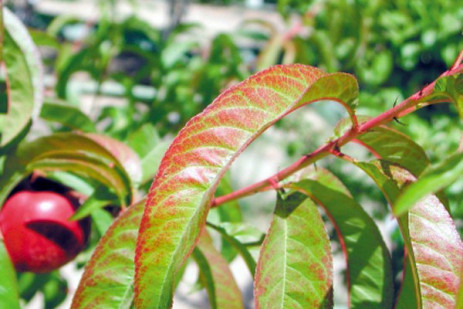Unlike agronomic or most vegetable crops, orchards are perennials. Therefore, they can potentially take up soil-applied/supplied nutrients at any time of the year if conditions are favorable.
Collecting leaf tissue for determining deficient or excessive levels is analogous to scouting for insects and diseases. Scouting is done to determine what problems you have and then will determine what you need to remedy or treat to prevent the problem from becoming worse. Fortunately, as a routine, leaf sampling only needs to be done once a year.
With scouting for insects, you know there are threshold values that if the population is below a critical level, you do not need to treat. The same is true with leaf analysis. You do not need to apply unusual foliar or ground fertilizers if the leaf analysis results indicate sufficient levels. Therefore, you are saving money by applying only the fertilizer that is needed.

Iron (Fe) deficiency in peaches. Photos: Rob Crassweller/Penn State
Leaf samples for nutrient needs are done from samples collected from mid-July to mid-August. The best samples come from one cultivar on one rootstock. We have recently been learning that some of the Geneva rootstocks may be more efficient in taking up certain nutrients. We have an ongoing study in cooperation with Cornell University to look at rootstocks that may be more efficient in taking up calcium, resulting in less bitter pit or corking in apples.
Samples from all tree fruit should consist of 50 to 60 leaves from the mid-section of the current season’s growth. The reason samples are collected in the mid-July to August time frame is because that is when nutrient levels are most stable. Early in the season some nutrients start out higher then decline, while others start out lower and increase during the growing season.
The macronutrients (N, P, K, Ca, Mg, and S) are reported as percent dry weight. The micronutrients (Cu, Zn, Mn, Fe, and B) are reported at parts per million or mg/kg of dried tissue. Macronutrients are those that are required in larger amounts than the micronutrients.
Collecting the sample
Collect healthy leaves from the midsection of the current season’s growth. Samples should be collected from the midsection or at chest height on large trees. For dwarf trees collect leaves at the height of the majority of the canopy. Sample kits with instructions can be obtained from the Penn State Ag Analytical Lab, 111 Ag Analytical Services Lab, University Park, PA University Park, PA 16802, [email protected], 814-863-0841.
Samples should be collected from one cultivar on one rootstock in a similar soil type. Soil types may have different fertility levels and that will influence what nutrients are available for absorption by the trees. Do not collect leaves from several different cultivars in a mixed sample. Do not mix leaves from old and young trees. Younger nonbearing trees have distinctly different nutritional requirements. Fill out the informational sheet accompanying the leaf sample as completely as possible. That information is used in making recommendations.
You do not need to wash the leaves. However, try to collect your leaf sample immediately before you apply a cover spray, or as long as possible after your last cover spray. Many of the fungicides used in cover sprays contain micronutrients that could impact the results. The same is true if you are applying calcium products for control of bitter pit or corking of apples.
If you suspect that you might have a nutrient imbalance or that the leaves look unusual, collect those as a separate sample and collect a second sample of leaves that appear normal. By comparing the two samples we can more easily determine if there is a problem. Table 1-2 on page 15 of the current guide shows the deficient, low, normal, and excessive nutrient level ranges for the major tree fruit crops.

Potassium (K) deficiency in apples.
What about sap nutrient analysis?
A new approach to nutritional level determination has been the suggestion of using sap analysis. This has developed a following in the production of tomatoes and other high-value vegetable crops. The methodology is to collect two types of samples. New young leaves and older mature leaves. Unfortunately, this has not been well researched for use in perennial tree fruit crops. In the vegetable crops there is no perennial structure that is used for the storage of nutrients. Perennial tree fruit crops can mobilize many nutrients from older senescing leaves back into the branches, trunks, and roots of the trees. In fact, much of these nutrient reserves are what trees utilize up until flowering. Once the soil warms up in late spring then tree nutritional needs are met from root absorption.
There has been little research on the use of sap analysis for perennial tree fruit crops. We do not know of appropriate sufficient values for comparison. Eventually we may develop these standard values but until then, the standard old leaf sample analysis is still the best methodology.
For more detailed information please refer to pages 13 through 17 in the 2020-21 Penn State Tree Fruit Production Guide.
– Robert Crasweller, Penn State University
Photo at top: Nitrogen (N) deficiency in peaches.

















